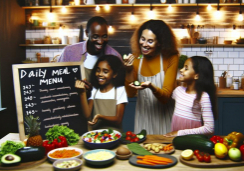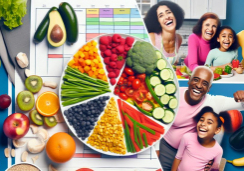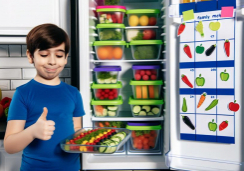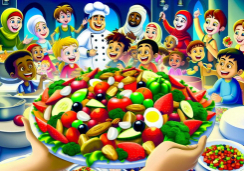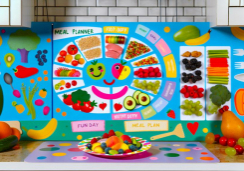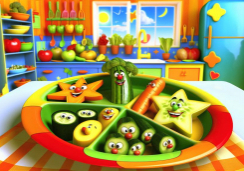Ultimate High-Protein Vegan Meal Plan: 15 Recipes
Just as Hercules faced his twelve labors, embarking on a vegan diet can seem like a herculean task, especially when aiming to meet your protein needs. You're often bombarded with questions about where you get your protein from and whether you can actually thrive on plants alone. Rest assured, this ultimate high-protein vegan meal plan, featuring 15 diverse and appetizing recipes, is meticulously crafted to ease those concerns.
You'll discover that it's not only possible but quite simple to fuel your body with the necessary nutrients without relying on animal products. Each recipe is a testament to the variety and richness of plant-based foods, ensuring you don't miss out on flavor or functionality.
As you consider how to incorporate these meals into your daily routine, remember that the key to a successful diet lies in its sustainability and how well it aligns with your lifestyle.
Let's look more closely at what this plan has to offer, and perhaps you'll find the inspiration to transform your dietary habits in ways you hadn't imagined possible.
Calculating Your Protein Needs
To optimize your health and body composition, it's crucial to calculate your protein needs, aiming for about 0.8 to 1.6 grams per kilogram of your body weight. This range is essential to support muscle repair, hormone production, and numerous other bodily functions. The exact amount of protein you need depends on factors like age, sex, activity level, and overall health.
When planning your meals, consider the grams of protein per serving to ensure you're hitting your target. A food scale or measuring cups can be invaluable tools for portioning out your meals accurately. If you're unsure about the amount of protein in different foods, consult with a nutritionist who can provide personalized advice, or use an online protein calculator as a starting point.
To track your intake effectively, consider using apps like Trifecta, which can help you monitor the amount of protein you consume each day. Remember, consistency is key when it comes to meeting your nutritional goals. By staying informed and mindful about your protein per serving, you'll be well on your way to a healthier, more balanced diet.
Plant-Based Protein Sources
You'll find that including a variety of plant-based proteins in your meals is key to getting all the essential amino acids your body needs.
Foods like tofu, tempeh, and legumes offer not only protein but also valuable nutrients such as fiber and healthy fats.
To ensure you're getting enough protein, consider combining different sources and being mindful of serving sizes throughout your day.
Diverse Protein-Rich Foods
Incorporating a variety of plant-based protein sources, such as tofu, tempeh, whole grains, beans, and plant-based yogurts, is essential for a balanced and nutritious high-protein vegan meal plan.
While most plant proteins aren't complete, combining different types ensures you get all essential amino acids.
Your plant-based diet should include these diverse protein-rich foods, which also offer healthy fats and fiber.
Beyond just protein, it's important to diversify your carbohydrate sources with whole grains and fruits to maximize fiber and nutrient intake.
High-protein snacks, containing at least 5 grams per serving, are excellent for meeting your protein goals and managing hunger.
Optimal Protein Combinations
Mastering the art of optimal protein combinations can significantly enhance the nutritional value of your vegan meals, ensuring you're getting a complete profile of essential amino acids.
When you're assembling high-protein vegan recipes, think about how plant proteins can complement each other. Pairing legumes with grains, nuts, seeds, or vegetables is a smart move; it creates a complementary amino acid profile that's vital for your body's needs.
For instance, combining rice and beans, layering hummus on whole grain pita, or serving tofu with quinoa are all great ways to get balanced protein intake.
Balancing Macronutrients
When planning your high-protein vegan meals, it's essential to consider the optimal protein-carb ratio that supports your energy needs and fitness goals.
You'll also need to incorporate healthy fats, which are crucial for nutrient absorption and overall health.
A variety of vegan protein sources ensures you get all the essential amino acids your body requires.
Optimal Protein-Carb Ratio
To optimize your health and body composition on a vegan diet, it's crucial to find the right balance between proteins and carbohydrates. High protein meals are vital for muscle repair and growth, while carbohydrates provide the energy needed for daily activities. Aiming for 0.8-1.6 grams of vegan protein per kilogram of body weight can help you maintain this balance.
Consider incorporating a Protein Veggie mix into your meals to ensure you're getting a spectrum of nutrients. Use a food scale or measuring cups for accurate portions. Consulting with a nutritionist or utilizing a protein calculator can tailor your intake to your specific needs. To track your progress, the Trifecta App can be a helpful tool in maintaining the optimal protein-carb ratio for your vegan diet.
Importance of Healthy Fats
Understanding the role of healthy fats in your diet is essential, as they're not just a source of energy but also support critical functions like brain health and vitamin absorption.
When you're crafting a high-protein vegan meal plan, don't overlook the importance of these fats. Integrating sources like avocados, nuts, seeds, and olive oil ensures you're getting a spectrum of vital nutrients.
Healthy fats aid in hormone production and facilitate the absorption of fat-soluble vitamins—A, D, E, and K—which are crucial for your well-being.
Balancing macronutrients by combining healthy fats with high-protein and carbohydrate-rich foods can help maintain sustained energy and promote a sense of fullness.
Paying attention to both quality and quantity of fats is vital for optimizing your health on a vegan diet.
Vegan Protein Sources
Diversifying your protein intake with beans, lentils, whole grains, nuts, and vegetables is key to balancing macronutrients in a high-protein vegan diet. These vegan protein sources aren't only a great source of protein but also provide other essential nutrients that support overall health.
- Beans and Lentils: Staple ingredients in high protein vegan recipes, packed with fiber and iron.
- Whole Grains: Quinoa and brown rice offer complete proteins and vital amino acids.
- Nuts and Seeds: Almonds, chia seeds, and hemp seeds are dense in protein and healthy fats.
- Vegetables: Spinach and broccoli contain protein and a plethora of vitamins and minerals.
Including a variety of these foods ensures a balanced diet that supports muscle growth, energy production, and well-being.
High-Protein Breakfast Ideas
Starting your day with a high-protein vegan breakfast, such as a savory tofu scramble or a refreshing protein smoothie, can provide the energy and nutrients needed to fuel your morning activities. A tofu scramble, rich in plant-based proteins, resembles the classic scrambled eggs but is entirely animal-free. It's versatile, allowing you to toss in a mix of colorful veggies for added vitamins and minerals.
For a quicker option, blend up a protein smoothie. You can throw in a variety of fruits, a handful of leafy greens, and a scoop of plant-based protein powder. Don't forget to sprinkle in some hemp seeds, which aren't only protein-rich but also a great source of omega-3 and omega-6 fatty acids.
When picking breakfast options, aim for balance. Including a source of complex carbohydrates like oats in your breakfast muesli, alongside protein from plant-based yogurts or tempeh, will keep you satisfied and energized. If you're on the go, consider high-protein snacks like vegan protein bars or a yogurt parfait layered with fruit and nuts.
Satisfying Lunch Recipes
As you transition from breakfast to lunch in your high-protein vegan meal plan, consider the versatility of protein-packed salads and hearty vegan sandwiches. These meals aren't only rich in essential nutrients but also provide a balance of protein, fiber, and healthy fats to keep you energized throughout the afternoon.
Incorporating a variety of beans, whole grains, and nuts into these recipes can boost your protein intake while offering a satisfying and flavorful lunch experience.
Protein-Packed Salads
Embrace the fusion of flavor and nutrition with protein-packed salads that turn your vegan lunch into a muscle-fueling feast. These high-protein vegan meals are more than just leafy greens; they're a symphony of textures and tastes that satisfy your body's needs.
Imagine biting into:
- Crisp salads topped with hearty cubes of marinated tofu or tempeh.
- A mix of black beans, corn, and vibrant bell peppers, drizzled with a zesty lime dressing.
- Tender steamed edamame sprinkled throughout for a satisfying crunch.
- A bed of dark, leafy greens like spinach, accented with roasted asparagus and mushrooms.
Each ingredient is chosen for its nutrient profile, ensuring you get a balanced meal that's rich in protein and essential vitamins.
These salads are a testament to the delicious versatility of high-protein vegan meals.
Hearty Vegan Sandwiches
Sink your teeth into a robust vegan sandwich, a lunchtime staple that's brimming with plant-based proteins and a spectrum of nutrient-rich ingredients to power your day. These hearty creations aren't just satisfying; they're packed with protein sources like legumes, tofu, and tempeh, nestled between slices of whole grains.
Each bite delivers a balance of macronutrients essential for maintaining energy levels and supporting muscle health. Opt for a variety of colorful vegetables to ensure you're getting a wide range of vitamins and minerals.
Vegan high-protein sandwiches are more than just a meal; they're a smart, delectable strategy for staying fueled and focused. With these sandwiches, you'll enjoy a fulfilling lunch that keeps you satiated and aligned with your health goals.
Nutrient-Dense Dinner Options
To ensure a well-rounded and nourishing end to your day, incorporate a variety of plant-based proteins like tofu, tempeh, legumes, and whole grains into your dinner routine. These foods not only provide the protein your body needs but also come packed with essential nutrients that support overall health.
Consider these nutrient-dense dinner options:
- Tofu Stir Fry: A colorful mix of non-starchy vegetables like bell peppers and broccoli, sautéed with tofu, provides a high-protein meal rich in vitamins and antioxidants.
- Tempeh and Asparagus: Grilled tempeh alongside fiber-rich asparagus can be a satisfying combination that offers both protein and important nutrients like folate.
- Black Bean Tacos: Filling tacos with black beans, avocado, and a variety of fresh veggies delivers not only protein but also heart-healthy fats and fiber.
- Brown Rice and Mushroom Bowl: Brown rice, a whole grain, serves as an excellent base for a bowl brimming with umami-rich mushrooms and leafy greens like spinach.
Each of these meals balances protein content with a diversity of vitamins and minerals. By choosing such dinners, you're on your way to meeting your nutritional needs while enjoying delicious and satisfying vegan dishes.
Protein-Packed Snack Selections
When you're on a high-protein vegan diet, choosing the right snacks can make a big difference in meeting your daily protein requirements. Opt for snacks that offer at least 5 grams of protein per serving; this not only aids in curbing hunger but also ensures you're getting a nutrient boost between meals.
Snack options like a handful of edamame, a vegan protein bar, or a yogurt parfait can provide quick, protein-rich bites that keep your energy levels steady and your meal plan on track.
Nutrient-Dense Snack Ideas
Incorporating high-protein snacks into your diet can significantly contribute to meeting your daily protein requirements and managing hunger effectively. As part of a high-protein vegan meal plan, aim for snacks that provide at least 5 grams of protein per serving. These snacks should be minimally processed and made from whole food ingredients to ensure you're getting the most nutritional value.
Here are some ideas:
- Edamame: Fresh or frozen, these are packed with protein and fiber.
- Vegan protein bars: Look for those made with nuts and seeds and supplemented with protein powder.
- Yogurt parfait: Use a high-protein vegan yogurt layered with fruit and nuts.
- Peanut butter on rice cakes: A simple and satisfying option that combines healthy fats with protein.
Quick Protein Bites
Quick Protein Bites are an effortless and satisfying solution to boost your protein intake. They offer a convenient selection of snacks that pack a nutritional punch with at least 5 grams of protein per serving.
When you're on the move or in need of a quick energy boost, these easy vegan options are ideal. Higher protein content is key to maintaining muscle health and keeping you fuller for longer.
Reach for whole food ingredients like edamame, which is a complete source of protein, or spread nut butter on rice cakes for a balanced snack. Vegan protein bars and shakes can also be smart choices when they're minimally processed.
Efficient Meal Prepping Tips
To streamline your high-protein vegan meal prep, start by accurately planning and portioning your meals with a food scale or measuring cups. Knowing exactly how much you're eating ensures you meet your protein goals without over- or under-eating. Consult with a nutritionist or use a protein calculator to tailor your intake to your needs. This step makes your vegan meal prep both efficient and effective.
When prepping your meals, consider these points:
- Optimize Your Protein Sources: Integrate a diverse array of plant-based proteins such as tofu, tempeh, beans, and plant-based yogurts to keep your meals interesting and nutritionally balanced.
- Smart Carbohydrate Choices: Choose whole grains and fresh fruits over refined carbs and added sugars. This helps maintain steady energy levels and supports overall health.
- Meal Tracking: Use apps like the Trifecta App to personalize your meal plan and monitor your progress, making adjustments as necessary.
- Batch Cooking: Cook recipes in larger quantities to save time. Easy, high-protein vegan recipes that store well can be a lifesaver during a busy week.
Following these tips ensures your vegan meal prep isn't just a routine but a sustainable, health-focused lifestyle component.
Flavorful Protein Smoothies
After mastering your meal prep with high-protein staples, you can further enhance your protein intake with delicious smoothies packed with vegan protein powder and a medley of fruits and vegetables. These smoothies aren't just convenient; they're a powerhouse of nutrients.
Imagine a blend that supplies a whopping 31 grams of protein, not to mention the vitamins, minerals, and antioxidants from its plant-based ingredients.
Your high-protein vegan smoothies can be a symphony of seasonal flavors. Think of a fall-inspired mix with pumpkin, cinnamon, and a scoop of vegan protein powder to start your day with a festive note. But don't stop there. The beauty of these smoothies lies in their versatility. You can incorporate an array of fruits like bananas for sweetness, berries for a tart kick, and mango for a tropical twist.
In addition to vegan protein powder, other high-protein add-ins like hemp seeds and chia seeds can be used to further bump up the protein content and provide essential fatty acids. These ingredients aren't only nutrient-dense but also help in creating a satisfyingly creamy texture.
Creative Tofu Dishes
Have you ever considered the versatility of tofu in creating protein-rich vegan dishes that are as nutritious as they're flavorful? This plant-based powerhouse can be transformed into an array of delectable meals, ensuring you're never short on protein or taste.
Here's how to elevate your tofu game:
- Tofu Ricotta: Blend tofu with nutritional yeast, garlic, and herbs for a creamy substitute that's perfect for stuffing pasta shells or layering in lasagna.
- Scrambled Tofu: Mimic scrambled eggs by crumbling tofu and cooking it with turmeric, black salt, and your favorite veggies for a savory breakfast.
- Tofu Bowl: Assemble a hearty Tofu Bowl with brown rice, steamed greens, and crispy tofu cubes topped with a drizzle of tahini dressing.
- BBQ Tofu: Slice tofu into slabs, marinate in your favorite BBQ sauce, and bake until chewy and caramelized—an ideal protein punch for any meal.
Tempeh-Inspired Meals
While exploring the culinary possibilities of tofu enriches your vegan diet with essential proteins and flavors, don't overlook tempeh, another nutrient-dense soy product that can revolutionize your meal plans with its unique texture and versatility.
Packing a substantial 15 grams of protein per ½ cup serving, tempeh is a powerhouse in your high-protein vegan arsenal. It's not just about the quantity of protein; tempeh's quality protein contributes to muscle repair and growth, making it a favorite among fitness enthusiasts.
The beauty of tempeh lies in its adaptability. Its nutty and earthy taste pairs well with a myriad of seasonings and marinades, absorbing flavors like a sponge, which elevates every dish it graces. You can creatively incorporate tempeh into your meals, using it as a robust meat substitute in classics like stir-fries, salads, and sandwiches. Each recipe uses tempeh's firm texture to stand up to cooking methods that tofu mightn't endure, such as grilling or sautéing.
When you're crafting your next meal, consider tempeh an essential ingredient. It's not just a sidekick to tofu; it's a star in its own right, ready to liven up your vegan meal plan with its rich, savory profile and high-protein content.
Legume-Focused Dishes
Diving into legume-focused dishes, you'll find they're not only rich in protein but also packed with vital nutrients that are essential for a well-rounded vegan diet. These dishes ensure you're getting enough protein, which is often a concern when adopting a plant-based lifestyle. By including a range of legumes such as beans, lentils, and chickpeas in your meal plan, you can effortlessly boost your protein intake.
Legume-focused dishes are incredibly versatile, suitable for both lunch or dinner, and can be tailored to a variety of dietary preferences. Here's a snapshot of what you can look forward to:
- Chickpea Quinoa Lentil Stew: A hearty and warming dish perfect for cooler days.
- Lentil Curry with Quinoa: Spiced to perfection, offering a flavorful protein punch.
- Chickpea Salad Wraps: Fresh, light, and packed with protein for a quick meal.
- Black Bean and Corn Salad: A vibrant and nutrient-dense option for a summer lunch.
Each of these dishes is a testament to the diversity and nutritional value of legumes. They're not just about getting enough protein; they're about enjoying a variety of textures and flavors while nourishing your body. So, embrace legume-focused dishes as a staple in your high-protein vegan meal plan.
Seitan-Based Entrees
Why not elevate your vegan meal plan with seitan-based entrees, a protein-packed alternative that offers both versatility and a meaty texture? Seitan, also known as wheat gluten, has become a cornerstone for those seeking to ensure they're getting enough protein on a vegan diet. In fact, seitan-based dishes are a smart addition to any high-protein vegan meal plan, given how much protein this plant-based source contains.
Seitan's chameleon-like qualities mean it can take on a myriad of flavors and textures, making it an excellent substitute in recipes traditionally made with meat. You can marinate it, grill it, sauté it, or even shred it to mimic the texture of pulled pork or chicken. This adaptability ensures your meals remain exciting and varied.
When crafting seitan-based entrees, consider the balance of your dish. Not only is seitan high in protein, but it's also important to combine it with a colorful array of vegetables, whole grains, and healthy fats to achieve a nutritionally complete meal. By experimenting with different recipes, you can discover how seitan can be transformed into delectable vegan versions of your favorite dishes, all while contributing significantly to your daily protein intake.
Protein-Rich Vegan Desserts
Satisfy your sweet tooth and meet your protein goals with indulgent vegan desserts crafted from ingredients like chickpeas, quinoa, and nut butters. In your high-protein vegan meal plan, don't overlook the importance of a delicious finale that complements your nutrition objectives. You can create satisfying treats that are both protein-rich and utterly delectable.
- Chickpea Chocolate Chip Cookies: Blend chickpeas into your batter for a protein boost and a surprisingly perfect cookie texture.
- Quinoa Pudding: A twist on the classic rice pudding, using quinoa for a complete protein source and a nutty flavor.
- Nut Butter Brownies: Swap out oils for almond or peanut butter to add protein and a rich, gooey consistency.
- Tofu Mousse: Silken tofu whips into a creamy mousse that's high in protein and completely customizable with your favorite flavors.
Incorporating protein-rich ingredients like these not only contributes to your daily protein intake but also provides essential nutrients that support overall health. Even desserts can be a part of a balanced diet when they're thoughtfully prepared.
Weekly Meal Plan Sample
Embark on your high-protein vegan journey with a weekly meal plan that incorporates 15 innovative recipes, ensuring you get the essential nutrients your body needs without sacrificing flavor or variety. Your high-protein vegan meal plan is a carefully curated selection of breakfasts, lunches, and dinner recipes that offer a balance of proteins, vitamins, and minerals critical for optimal health.
Kick-start your mornings with the cheesy vegan tofu scramble, packed with plant-based protein to fuel your day. Mid-week, switch to a vegan breakfast muesli for a fiber-rich start. On-the-go? Blend up a vegan vanilla chai protein smoothie for a quick nutrient boost.
Lunches could feature the hearty vegan California burger, which combines taste with protein-dense ingredients. Later in the week, enjoy the vegan high-protein veggie pasta for a satisfying midday meal.
As for dinners, this weekly meal plan sample includes a rotation of protein-rich recipes that ensure your evenings are as nutritionally rewarding as they're delicious. Experiment with different spices and herbs to add layers of flavor without relying on animal products.
Frequently Asked Questions
What Vegan Food Has the Highest Amount of Protein?
You'll find the highest protein in legume varieties like lentils, with 18 grams per cup. Plant-based powders and protein-packed grains like quinoa are also excellent sources for your muscle growth and repair.
How to Get 150g of Protein a Day Vegan?
To get 150g of vegan protein daily, diversify with protein powder choices, ensuring complete amino acid profiles. Balance meals for muscle building, focusing on nutrient-rich sources like legumes, seeds, and nuts.
What Do Vegans Eat on a High Protein Day?
On a high-protein day, you'll munch on protein-rich snacks like nuts and seeds, fuel muscle building with lentil dishes, and pair plant-based proteins with grains to optimize amino acid profiles.
How to Get 20g of Protein per Meal Vegan?
To get 20g of protein per meal vegan-style, combine legumes, seeds, and nuts. Don't rely solely on protein-packed snacks or plant-based supplements, and dispel vegan protein myths by choosing nutrient-rich whole foods.
Conclusion
You've got the tools to fuel your body with plant power! Remember, tailor your protein intake to your needs, and don't shy away from a mix of beans, lentils, tofu, and seitan.
Balancing your macros is key for optimal health. Dive into these high-protein meals, from energizing breakfasts to hearty dinners and even sweet treats.
Embrace this guide, plan your week, and watch how satisfying a high-protein vegan diet can be for your body and taste buds!



